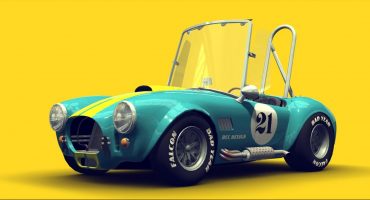I’m Edgars Soiko a 27 year old 3D game artist, born in Riga, Latvia. I graduated from Latvian University in 2014 with bachelor’s degree in Graphic Design. I was somewhat involved in art from a young age, however I started experimenting with 3D modeling when I was around 16 years old. I’ve always been passionate for games and while studying in University, I realised that I didn’t see myself doing Graphic Design for a living. That’s when I met fellow student – Kaspars Pavlovskis, who had already started doing some models for games. At this time I started thinking about a career in the games industry and took a real passion in developing my skill with every work. At the moment I’m working as a 3D artist at a mobile game company and as a freelancer for PC/Console type projects. Back in 2015, Kaspars and I teamed up to create Polysquid Studios – a small art outsource studio that we have slowly but steadily been growing ever since.
Idea:
The Model was done for an upcoming game – Private Eye, a Psychological VR puzzle game, set in the 1950’s. I’ve been working on this game for quite some time and I really enjoy making models that are from this time period, mainly because the shape language is so clean and materials used are much more genuine than modern day counterparts. Mainly metal, wood and leather, no cheap flimsy plastic here – all of the everyday objects have so much more personality to them. Tape Machine was a part of an environment level that I am making for the game: Detective Office.

The Model is going to be an interactable in the game. The player would find tape-reels around the level and play them in the machine, as a part of puzzle-storytelling. The reference for this model was the Ferrograph Logic 7 – reel to reel tape recorder. Starting out with the model was a bit scary as there are a lot of mechanical parts and I had little clue how this thing actually worked.
After investigating the references I decided that the best and the fastest way to approach a model like this would be to split it up into parts and model them separately, assembling the complete model very late in the low-poly stage. I looked at the reference and numbered the parts, to not lose track of what needed to be made.
As far as modeling goes, I used Blender and pretty much a standard workflow. A lot of thinking was put into putting a lot the detail in all of the little knobs, dials etc, because those would be the natural focal point of the model. After that, I made game-res versions of each part and did the UV’s. Baking the texture maps was done in Substance Painter.
After that came the fun part – putting the model together from the pieces I had made and figuring out a way to make the player look believable. In the end this worked, because the player is made out of many, relatively simple shapes, that are reused throughout the model.
Texturing was also done in Substance Painter. For me this is the most important step in the workflow, as good materials can make or break the model. I used 4K textures for the Machine and 2K for the reel. I started out with the base materials – wood, brushed aluminium, painted metal, etc. Dialing these in just right is important, because they make up most of the model. After that, came the detail work. There are a lot of things that need to be done, to make a model like this believable. I tried to map out all of the knobs’ function’s names and paint them in. I didn’t do this 1/1 as in the ref but I tried to get as close as I could without spending too much time.
Substance Painter has a nice feature, which allows you to use type fonts as alpha masks. This tool made things a lot easier, as before all of the alpha masks had to be pre-made in Photoshop. Getting a good detailed material definition is also important – for example, to differentiate polished steel from brushed aluminium – and adds a lot to the complete impression. After the model was finished I exported the textures for Unity3D Standard shader (Diffuse, Metallic+Gloss, Normal) and also for Sketchfab.

Sketchfab
I was thinking how to present the model in Sketchfab and I decided to create a simple animation for the tape-reels and the VU meter and add some creepy voice recording I found on a stock sound site. After importing I added some warm key light and some cooler secondary lights, so nothing fancy. AO, Bloom and AA were added as well as a few color balance tweaks to add some “vintage” feel For me as a real-time 3D artist Sketchfab is one of the most effective ways to present my work as it can seamlessly display PBR quality models on pretty much any platform and has great community support.







